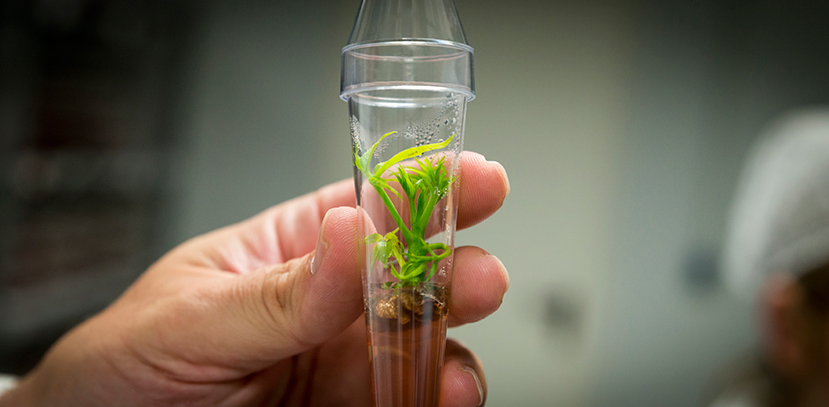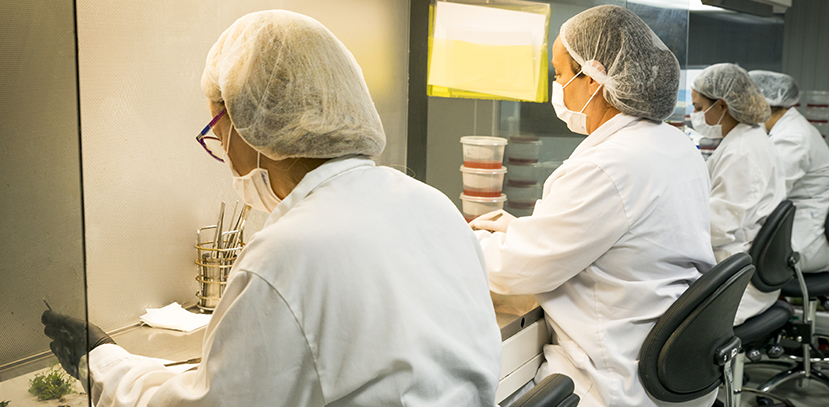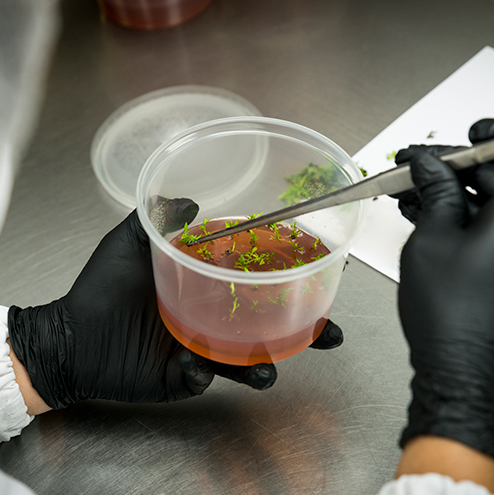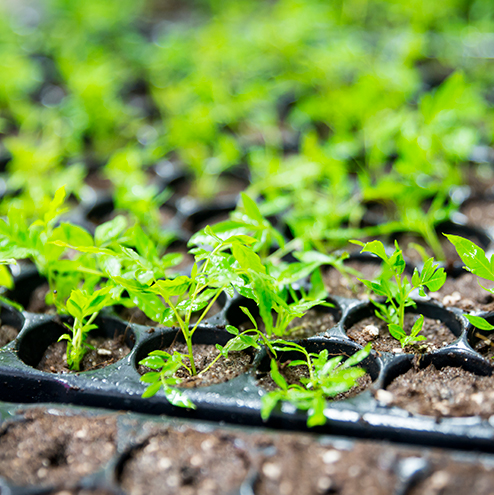¿ABOUT US?
BIOTECNOLOGY AT YOUR SERVICE
At Meristec we research, innovate and develop plant production systems using plant biotecnology to fulfil the demands of the agricultural market. Our know-how in terms of plant tissue culture propagation reflects the professionalism and resposibility of our entire team, always looking to bring out the potential of each plant species.


Since 2013, we have had a group of researchers specialized in the development of plant micropropagation systems with more than 20 years’ experience in the industry. A team dedicated to laboratory work and plant tissue culture, as well as offering commercial advice on solutions for projects and plantations. We are your trusted plant production centre, leader in the walnut and pistachio market, which uses advanced techniques to offer our customers the best products to make their orchards proditable.
¿WHY MERISTEC?
MICROPROPAGATION
We massively produce plants of a clone or variety by tissue culture or micropropagation. This means the use of controlled laboratory conditions to propagate an original mother plant and produce genetically identical plants to it.
INNOVATION
We use leading plant biotechnology techniques in the industry to propagate the plants of interest for our customers. Our goal is to optimize the profitability of their orchards.
COMMITMENT
We advise on the profitability and improvement of agricultural projects and meet each custumer’s requirements in a timely manner. Our goal is to increase the potential of the crops in a friendly and professional way.

MISSION
Our mission is to provide a research, development and productive vegetative advisory service through innovative micropropagation procedures.
VISION
We want to be a world biotechnological benchmark in plant tissue culture, exploiting the most profitable agricultural mass production demanded by the industry.


VALUES
– Innovation and research.
– Committed to our customers.
– Fulfilment of delivery times.
– Profitability and efficiency.
– Professionalism.
– Productive quality.
– Social respect.
R + D + i
OUR TECHNIQUES, OUR GUARANTEE
Meristec’s objective is based on competitiveness and the creation of exclusive products with a high economic interest, based on the effort and investment in R+D+i, in order to establish methods and technologies necessary for its development.
The walnut tree, both as a producer of walnuts and fine hardwood with a high economic yield, pistachios and blueberries, are species which our entire team carries out intense investigation and development work on. Procedures that manage to produce plant materials that are resistant and tolerant of diseases and/or bacteria in order to obtain crops that reduce phytopathological problems to the minimum, diminishing the use of chemical and phytosanitary products in most cases. A commitment marked by relationships with research centres and universities working on the selection and improvement of these species.
Commercial micropropagation is the large-scale production of plants of a variety or clone. In the plant world this cloning process occurs spontaneously, in such a way that several plants are able to emit roots in organs (stems or leaves) producing others that are genetically identical to them. This would be a vegetative or asexual reproduction of plants: a process by which, for more than two thousand years, new productions adapted to the environment (nurseries) have been generated. there are a variety of procedures, among which we highlight the proliferation of axiliary buds: increasing the plants’s buds thorough axillary buds under laboratory conditions, obtaining several new buds that will be later rooted to obtain the whole plant. In the traditional nursery this process is carried out under greenhouse or field conditions, and in the laboratory by in-vitro cultivation under sterile conditions with exhaustive temperature, humidity and lighting control. This last option focuses on the control and maximum optimization of the plant on each of its factors to achieve greater performance.
1. Buds or meristems are taken from a mother plant that corresponds to the variety or clone to be propagated.
2. They are disinfected and sown in a lissue culture medium under aseptic condition, provoking sprouting. the shoots ontained produce, in tum, more shoots from their own buds.
3. In the event that the new shoots do not reach the sufficient size or are strissed by the growth regulators, they are thansferred to another composition medium to improve their growth through elongation.
4. Elongated shoots are transferred to another medium for rooting. Its treatment in the laboratory requires adequate acclimatization until it reaches the enveronmetal conditions necessary for its normal decelopment in the plantations.
At Meristec we produce both self-rooted plants of the best varieties/cultivars, as well as the first selected clonal rootstocks. In this way, our customers can choose the best rootstock-scion combination or self-rooted variety that adapts to their climatic conditions.
INTERNATIONAL EXPANTION
Meristec carries out work that is constantly innovating in order to respond to all our customer’s demands. For this reason, we respond to the requests of the international market in order to focus our research efforts around the production of new clonal plant species of the highest quality and which produces the maximum yield.
¿Do you have a proposal? Let us hear it.
We solve your doubts
The criteria for deciding on the type of exploitation to be developed are purely financial.
Producing walnuts means investing in a very profitable crop, with a short-medium term return (harvest begins between the 4th and 5th left), which requires an investment in fixed assets (harvesting machinery, processing facility) that, at the same time as incresing the profitability of the project, determine the existence of a relationship between surface and profitability (the larger the surface, the easier it is to recoup the assets that are acquired).
Producing timber implies an extraordinary return (much higher than walnuts) with a long retun period (between 22 and 25 years). The acquisition of equipment is not necessary, beyond the installation of irrigation and work machinery (the latter could be leased, in the case of small farms), which means that profitability isn’t so dependent on the surface. The necessary dedication is mush less in terms of time and resources, so professionals from other industries tend to have less difficulty producing timber than walnuts, on land that they do not plan to use for another activity, and that are being revalued each year by the mere fact of having planted walnuts trees (whose value increases as they grow).
In short, if it is necessary to have liquidity in the medium term obtained from our project with walnuts, it is better to start a nut orchard. If what is intended is to develop a highly profitable “retirement or investment plan”, with almost no risk and very little dedication needed, timber production becomes a very interesting alternative.
Each type of crop has its own requirements, which are very different from each other. For example, to produce timber it is necessary to train tall trees (more than 5 m) and large diameter trunks that are free of wounds from thick branches. However, a French study indicates that in a walnut tree orchard for nut production, for every 20 cm that we raise the lowest productive branch from the ground, we increiase the the nut bearing be one year, in graphic terms to obtain a clean trunk of 5 m tall branches we would have to postpone the first harvest for 25 years! it is clear that both systems are not very compatible. In order to optimize yields, the varieties used for nut production have completely different traits to those used to produce timbers (in some cases, hybrids with a high degres of sterility, which practically won’t produce nuts in order tp devote almost all their energy on producing timber).
Although for Meristec it would be an interesting commercial argument to sell a tree whose timber, after producing nuts for 25 years, has a great market value, we have to discard the possibility of using the same tree to produce walnuts and wood at the same time.
Producing walnuts and timber (in different trees) in the same orchard can be a different situation initially increasing the tree density of a farm with the ultimate goal of producing wood using walnut trees for the production of timber (for example, in a 8×8 m ordhard intersoersed with 4 m walnut trees for nut production) could have a beneficial effect in the first years (increase in competition, improvement of apical dominance and straightness of timber trees, reduction of pruning and training needs) and allow us to produce nuts until the competition forcer to clear out the nut trees to maximize timber development.
In any case, these types of orchards are being studied. It is necessary to evaluate aspects such as the influence of the greater growth in height of the walnut trees in the availability of light for fruit walnuts, the increase in cost that the use of insecticides in a timber plantition implies that, under other conditions, wouldn’t need and, ultimately, if the increase in investment is truly profitable.
At present, most of the walnut orchards that are being developed have a single clear objective: either nut or timber production.
The answer is very simple: the one that best suits the edaphoclimatic conditions of our orchard. It will depend on whether our climate is very cold, warm, if we have late spring frosts, enough chilling or not, if our soil is limestone, deep, clayey…
We consider it of utmost importance to use the material that works best on our customer’s farms. It is much easier to get the right plant material for our conditions than to try to adapt the conditions of our farm (which in many cases may be impossible) to the material that is offered to us.
Meristec has a wide diversity of varieties and clones, both for nut production and wood production. If you want to know what the material that will give you the highest yield in your operation is, ask us for personalized information for free through our technical/commercial department.
It will depend on several factors:
– If you are going to produce nuts or timber
– The variety or cline to be used (for its vigor)
– The edaphoclimatic conditions of your farm, which will condition the duration and quality of the vegetative period, and therefore, the growth potential of our conditions
– Aspects related to management: irrigation availability, fertigation system
If you wish to consult what the optimal planting framework of your plantation would be, we suggest requesting personalized information for free through our technical-commercial department.
Very low requirements. One of the great advantages of the crop is precisely due its low dependence on external labour.
Walnut trees for nut production are highly mechanized, from pruning (with pruning speeds that can reach 14 Ha /hour) until harvesting. Walnut trees for timber are obviously not harvested and only requires training and pruning (during the first 6-7 years), therefore the labour needs are much lower than those of walnut trees for nut production.
The walnut tree is a lush noble tree with high water needs. Its leaf surface is high and has less stomatal regulation of dehydration in stress situations than other similar trees.
The maximum water requirements of a walnut plantation can vary, depending on the evapotranspiration of the reference crop of the area, between 6,500 and 8,500 m3/ha per year (trees in their highest stage of development).
The behaviour of a walnut plantation under deficit irrigation conditions has different consequences, depending on whether we are cultivating walnut trees for walnut or wood production.
In the case of walnuts, the availability of water, in particular in summer (period when the fruit fattens), is essential to achieve an optimum size and commercial quality of the nut. In short, if we don’t have enough water in summer (to be taken into account, because in certain regions with sufficient total rainfall it may not rain when needed) the viability of the crop becomes highly compromised, because the nut obtained may not makes its way to the market.
If the aim is to produce timber, deficit irrigation can cause a reduction in annual growth, which, although it does not compromise the viability of the project as much as for nut production, it can reduce the timber’s value by causing unevenness in the diameter of its rings.
In most of the exploitations to develop, our recommendation is a fertigation installation that assures us the development of the maximum potential of our plantation with the least possible dependence on climatology. We consider that, on the one hand, given the high profitability of projects such as this, it is not beneficial at all to jeopardize it partially or totally to carry out an investment that implies a minimum part of anticipated future earnings, and whatever other elements we put in favour of maximizing the development of the trees, the greater this profitability will be. In other words, given the high profitability that is pursued, it is preferable to reduce our reliance on factors such as the climate to achieve it.
The best irrigation strategy is to wet 60% of the projection of the canopy and cover all the tree’s needs. Controlled deficit irrigation strategies do not work for this species.
To receive personalized information for free and resolve your current doubts, don’t hesitate to consult our technical-commercial department
Walnut trees need deep soil (more than 1.5 m in plants tap roots, more than 80-90 cm in self-rooted plants, see differences in the root system of both types of plants), as fertile as possible, with a pH between 6.5 and 8.0 (although there are self-rooted walnut trees growing well in soils with pH> 8.5), with low levels of active limestone, with a structure that allows adequate drainage (waterlogging causes root asphyxia and the appearance of root diseases, therefore it is practically incompatible to grow walnut trees), a water table level not exceeding 1.5 m (in summer). The species does not tolerate salinity or excess in certain micronutrients, such as boron.
In practice there are a lot of factors related to the soil that interact with each other, therefore each soil is different from the others. Consequently, attempting to generalize about soil characteristics where the walnut tree may or may not have issues is complicated.
In virtue of what has been discussed, Meristec always suggests carrying out a soil analysis, taking samples about 50 cm deep, from which we have to request a complete analysis (macro and micronutrients) in saturated extract, in which we have to determine both the chemical composition and the physic structure. The samples must be taken in all those plots of our farm that show, at a glance, more or less clear differences (colour, structure …). The ideal situation would be to complement the analysis with the realization of soil pits (perforations with a backhoe) that give us an idea of how our soil profiles are structured; although this task has to be carried out by a competent technician.
With the results obtained in the tests carried out on your land, you can request personalized information free of charge on the viability of a walnut tree plantation on your farm.
Obviously, it can be difficult to predict the effects that a significant variation in the behaviour of the climate (especially as it has been changing in recent years) may have on our orchaird,but we can refer to the most common cases for each situation.
Late spring frosts can seriously affect annual growth, and even irreversibly damage young plants. As a result, both nut production for the year and vegetative growth can be compromised.
Preventing this situation is relatively simple: everything will depend on having made an adequate choice on the variety or clone to be used. Meristec has a wide selection of plant materials, where it is easy to find the clone or variety that will have no problems in your orchard.
As for the early frosts in autumn, although they can be even more harmful than those in late spring, it is much easier to prevent them, as it is essentially a management issue: it is necessary to stop the growth of the trees at the right moment to allow an adequate lignification of the year’s growth, making the plant become sufficiently hardened to the frost risk period. A suitable chosen variety can also prevent damage caused by this type of circumstance, as some plant materials grow until well into the autumn, increasing this risk.

